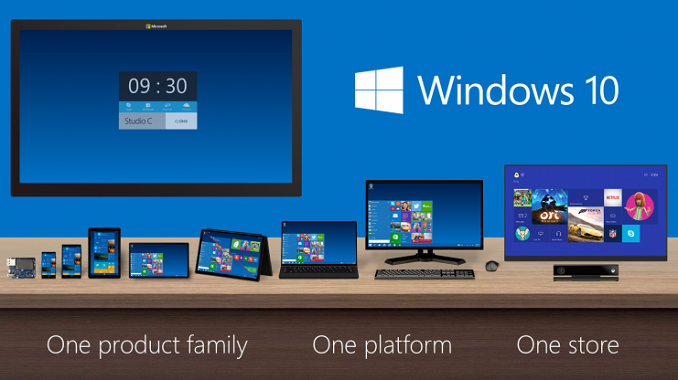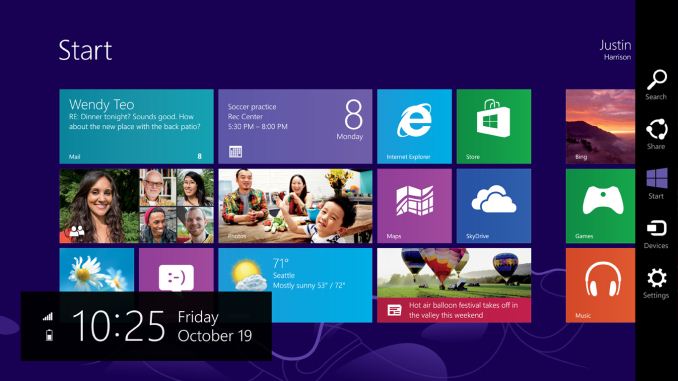Windows 10 Technical Preview First Impressions: The Return Of The Desktop
by Brett Howse on November 13, 2014 8:00 AM EST- Posted in
- Software
- Microsoft
- Windows 10

I’ve said this before, and I will reiterate it now. Windows 8, in general, is not perceived in a positive light. Not necessarily because of the lack of features, or even due to the touch first interface, but because from the start people did not buy into the paradigm. We can argue over why that was, and the specifics are likely different for every individual. But a big part of that was that Windows, which has had a familiar interface since Windows 95, had changed dramatically in look, feel, and general use. The traditional mouse and keyboard PC and notebook is a big part of the Windows user base, and especially at the beginning, Windows 8 did not cater to that crowd. While there were certainly improvements to the desktop, it was not enough to overcome the negative feelings of many users in regards to being productive on their PC. I say this as a fan of Windows 8.1, and I say this despite the positive review from this site. Windows 8 was an OS that worked, but had a steep learning curve that many people did not want to bother learning.
One of the biggest issues facing Windows 8 was just how much people liked Windows 7. Windows 7 was seen as the savior to Vista, and fixed many of its issues. But a lot of the initial problems with Vista were due to a major change in the driver model as well as the security model, which caused a lot of compatibility issues with older programs which expected administrator rights, as well as many hardware devices needed driver updates. With Windows 7, all of those changes were in the rear view mirror, allowing 7 to be a tweak of the overall UI and functionality rather than a rebuild of the OS from the ground up. With Windows 8, the move to touch first caused another dramatic upheaval. This time, rather than incompatible programs and hardware, we got a new Start Screen, a new runtime in WinRT, and a new app model with the Windows Store. For reasons that will never be made clear, the familiar start button was even removed, with the designers relying on hidden functions such as the hot corners to navigate around the OS with a mouse and keyboard. Luckily this change was reversed for Windows 8.1, with the start button returning, even if it still opened the Start Screen. With the Windows 8.1 Update, the system was made much more usable for a mouse and keyboard with the return of the menu bar to close apps, rather than dragging them down off the screen, and several other changes as well which brought the balance back somewhat to cover both touch interfaces as well as the mouse and keyboard.
 Windows 8 at launch in October 2012
Windows 8 at launch in October 2012
With Windows 8, Microsoft tried out an operating system which would work with a single interface across a breadth of hardware, from small form factor tablets, up to 30” monitor desktops. While they certainly succeeded in creating an interface that worked across all of those platforms, it was not ideally suited to any of them. With the tablet mode, the new Start Screen worked very well, and the charms menu and app switcher were fairly easy to use. But many of the settings and programs would be on the desktop, where touch only worked sparingly. Some desktop applications, such as Office, were created with a touch mode to increase the size of the onscreen elements, but overall the experience was subpar. Similarly, on the desktop, the touch interfaces were not ideal, and the hot corners certainly had issues especially on multi-monitor systems.
Windows 10 Technical Preview at launch
But now we come to Windows 10. Windows 10 is ditching the “One Interface to Rule them All” mentality, and moving to a more user friendly model of a single store across all platforms, and multiple interfaces to the same OS depending on the current usage model. We have not seen all of this in practice as of yet in the Technical Preview, but Microsoft has demonstrated their solution to this change in input mode with a feature they are calling Continuum.
The goal is that those that are on a keyboard and mouse based system will have the traditional start menu and desktop, with apps in windows, but if you are on a touch based device, or if you go on a 2-in-1 from keyboard to touch, the system will switch to the Windows 8 style start screen with full screen apps.
One of the keys to having this experience is an app model that allows a developer to target this different user interface paradigms. Microsoft’s solution to this is Universal Apps.











198 Comments
View All Comments
darthrevan13 - Thursday, November 13, 2014 - link
If you're referring to Windows 8.1 then all those issues where addressed (except for the calculator). If you're referring to 10 then DON'T FORGET IS A BETA. Next time you write a program and launch a beta I'm gonna say it's BS because a lot of stuff is buggy then I'll see how you like it.sphigel - Thursday, November 13, 2014 - link
Search is still god awful in Windows 8.1 Update 1. I mainly use it as an app/utility launcher and it can't even get that right. If you're running 8.1 right now give this a try. Hit the windows key and type "devices" with the intent of launching Devices and Printers. If your computer is like mine you should see Devices and Printers as the top search result. Ok, now hit enter. Did Devices and Printers launch? Nope! It launched a freaking web search for "devices"! How convenient! Hitting enter doesn't even launch the top search result!MrSpadge - Thursday, November 13, 2014 - link
It doesn't do that if you have deactivated "include web into search results", which I always do. But you're right that hitting enter upon a search doesn't launch the top item, but (without internet search) rather a full page of the search results. I can see that being useful for some. BTW: in Win 7 you'd have to hit "arrow down" once after searching to get the topmost item, right? (can't test right now)sphigel - Friday, November 14, 2014 - link
I'll have to deactivate web search because I would never use that feature. Thanks for the tip. The other problem with it not automatically selecting the top result when you hit enter is made worse by the fact that it's inconsistent. On two fully updated Win 8 computers I can search for "Control Panel" and hit enter and it will launch Control Panel. However, even if I fully type "Devices and Printers" and hit enter it will not launch Devices and Printers even though it's the top search result. I have not found any logic behind when it chooses to launch the top search result and when it chooses not to. Win7 would always launch the top search result. I would often times start typing and just continue typing until what I was looking for moved up to the top of the list and then I'd hit enter. It was much quicker and more intuitive to use search in Win7.Brett Howse - Thursday, November 13, 2014 - link
When Windows 8 came out there was talk of the desktop being deprecated completely. Clearly that's not happening now.I agree there was a lot to like with the Windows 8.1 desktop especially, but a lot of people were confused by the Touch interface on top. In Windows 8.1 though, Modern apps just are not good productivity replacements for the most part since they are full screen. Even with snap, I found they got in the way when I was trying to get work done. Having them in a window is much easier on a desktop PC.
MrSpadge - Thursday, November 13, 2014 - link
I agree that for non-touch the modern apps are mostly worse than regular programs. But they're optional, so I fail to see how not having the choice to install & use them would be any better (implying that someone wants to use this argument against 8/8.1 compared to 7 - no question 10 is doing it better).kmmatney - Thursday, November 13, 2014 - link
For non-touch, modern Apps are even worse than their web page equivalents. I've been using Windows 10 on a spare computer and it's much better than Windows 8.1. The funny thing is, it almost exactly like my Windows 8.1 computer - which I spent a lot of effort on to remove all traces of Metro.TEAMSWITCHER - Thursday, November 13, 2014 - link
My only major grip with the Windows 10 Technical Preview (aside from the bugs) is the virtual desktop implementation. Having used OS X's Mission Control, you understand the importance of animating the experience. It provides you with the context of where you are in the multiple desktop environment. Windows 10's implementation as it exists today has jarring transitions with no ability to move windows between desktops or change the rearrange the desktops. Also assigning a unique wallpaper aids in positional awareness is not possible with this implementation.OS X has set a high bar for this feature andI'm really shocked by Microsoft's "amateurish" implementation. As it exists today...the feature should be removed to avoid embarrassment. Hopefully, someone at Microsoft will listen to the feedback and take action to dramatically improve this feature.
Brett Howse - Thursday, November 13, 2014 - link
Remember this is a technical preview of pre-release software. The Multiple desktops are one of the newest features. If you want it changed, check out the Windows 10 User Voice https://windows.uservoice.com/forums/265757-window... and add a suggestion there.It seems unlikely this brand new feature will not get updated before the final release.
beggerking@yahoo.com - Friday, November 14, 2014 - link
virtual desktop is ..so 90s..now a days we have dual / tri/ quad monitor setup. works much much better.